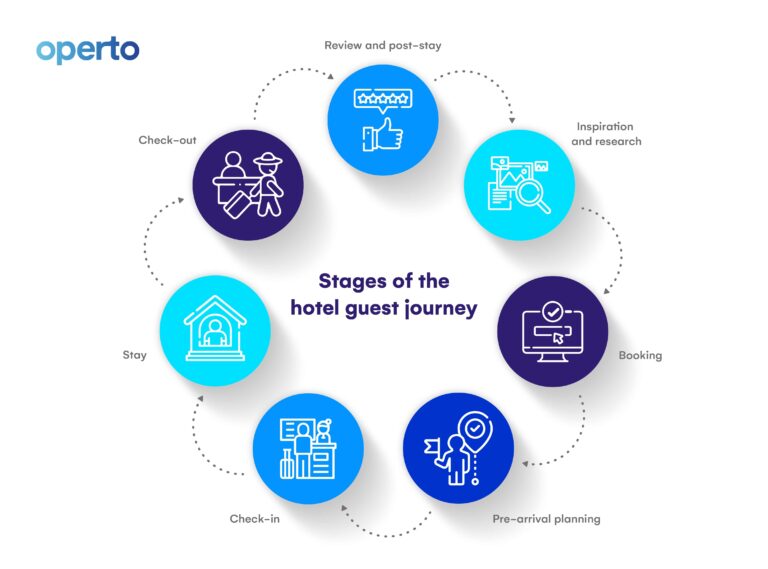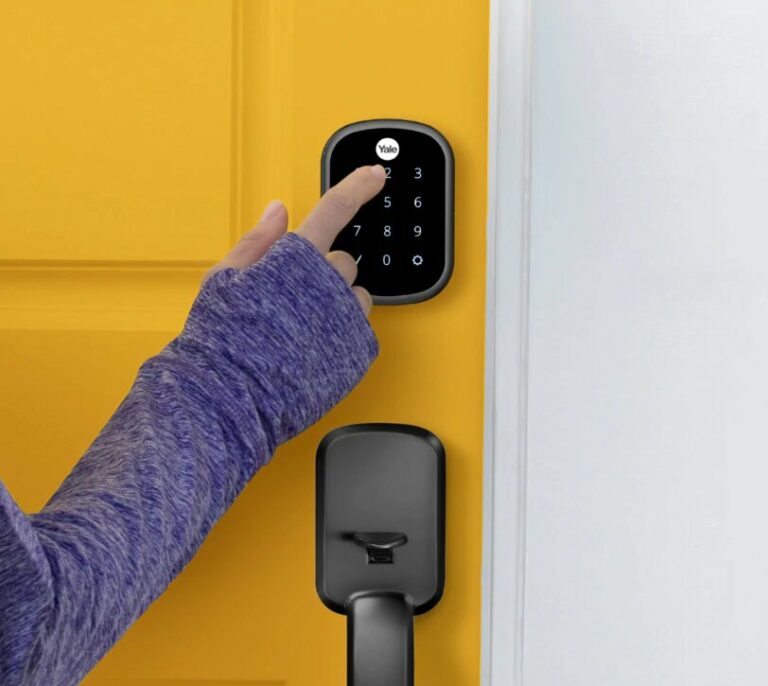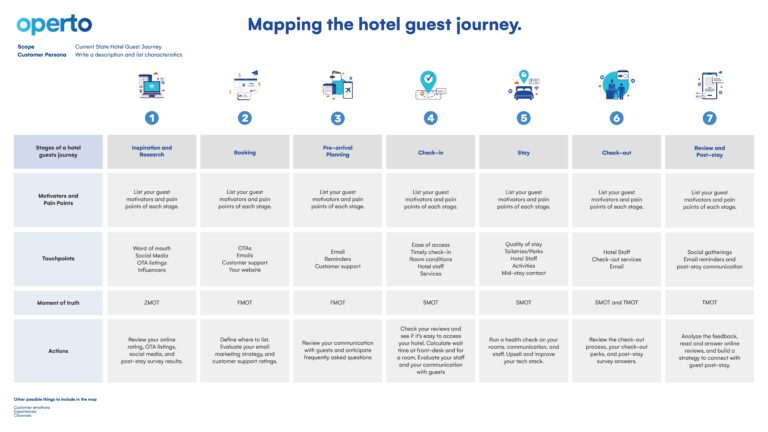A Step-by-Step Guide to Mapping The Hotel Guest Journey
But it can be hard to know where to begin. In fact, you might be asking at least one of these questions:
- What comes first? Scope or persona?
- Can it be on a spreadsheet? Or on specialized software?
- Who needs to share their input?
- Which type of template is the right one?
- Can one map include more than one kind of guest?
- What if I have different kinds of properties?
We’re here to help. We’ve done the due diligence for you and have compiled several online explanations into one complete step-by-step guide to hotel guest journey maps. We also lay out the particular steps you should review in your hotel or short-term rental.
Start giving your guests the vacation experience they really want.
What to focus on when mapping the hotel guest journey?
A hotel guest journey is a UX tool that helps you visually map all the stages your customer goes through while exposed to your services. A customer journey map should include their pain points, the touchpoints they have with your brand, and the channels they use to communicate with you.
The importance of mapping the hotel guest journey has become increasingly apparent with the rise of big data analytics. Every time a customer uses the internet, they leave a trace of data behind. Today’s customers are aware of that, and expect brands to anticipate their expectations. A customer journey map can help brands understand those needs and desires.
Mapping the hotel customer journey will allow you to:
- Improve brand perception
- Understand the guest experience
- Improve the quality of your touchpoints
- Be more empathetic with your guest
- Increase your positive reviews and get more bookings
- Identify and win moments of truth
What to focus on when mapping the hotel guest journey?
A hotel guest journey is a UX tool that helps you visually map all the stages your customer goes through while exposed to your services. A customer journey map should include their pain points, the touchpoints they have with your brand, and the channels they use to communicate with you.
The importance of mapping the hotel guest journey has become increasingly apparent with the rise of big data analytics. Every time a customer uses the internet, they leave a trace of data behind. Today’s customers are aware of that, and expect brands to anticipate their expectations. A customer journey map can help brands understand those needs and desires.
Mapping the hotel customer journey will allow you to:
- Improve brand perception
- Understand the guest experience
- Improve the quality of your touchpoints
- Be more empathetic with your guest
- Increase your positive reviews and get more bookings
- Identify and win moments of truth
Step 1: Define scope and type of map
The first step of creating customer journey map for hotels is to determine your goals and the scope. Once you defined your goal, you can choose one of these customer journey map templates to define the scope:
- Current state. This is planned to map the current state your guest is in. How they plan, act, and feel today. While it’s called “current state,” it’s meant to serve more as a retrospective to make future improvements.
- Future state. This template helps you guess what your guest will do in the future when presented with a new product or service. It’s like a pretend focus group.
- Day in the life. This template is similar to the current state. Its goal is to map how your guest plans, acts, and feels in the present but in specific situations that may or may not have anything to do with your business. This is useful to understand their pain points and see if there’s an untapped potential market.
Step 2: Outline your guest persona
A persona is an archetype of your target guest. You should give this persona a set of characteristics and write a description that explains who they are. To build a proper persona, you should review your guests’ information: Who they are, what they do, how they speak, and what they like/dislike?
It’s crucial that you get that information by speaking directly to hotel guests. Here are some of the things you can do to get this information:
- Conduct 1:1 or group interviews
- Ask guests to share feedback after their stay
- Revisit customer service conversations or service tickets
- Read your online reviews
- Use online forums and online reviews to read what guests like/dislike about hotels
- Invite employees who are in direct contact with guests to participate in the journey mapping
- Review where they are coming from (word of mouth, online ads, direct booking)
Step 3: Identify motivators and pain points
These two go hand in hand when mapping the hotel guest journey because one of the biggest human motivators is to avoid pain. And though your service is probably not causing physical pain to guests, they still experience what’s called a pain point.
A pain point is a problem or an issue your guest experiences with your service. Some examples include trying to book directly through your website if it’s glitchy, losing their key and not being able to contact you, or having to wait in line at the front desk.
Whatever your guests generally perceive as a pain point becomes your pain point, too. If they find it hard to book on your website, you’ll receive fewer bookings. Here are some of the reasons why something becomes a pain point:
- Money. Any activity that leads to your guest spending more money than advertised. For instance, hidden fees, invalid promotional codes, or false advertising.
- Time. This is a problem that pertains to anything that makes your guests lose time. Buggy websites, having them wait in lines at your front desk, housekeeping taking forever to tidy their room.
- Security. This relates to personal safety being at risk. Multiple people with access to your stay, insecure neighborhood, not having security personnel.
- Support. This one is about the support you give your guests. Ease of communication, low-quality service, inefficient problem-solving.
- Sense of well-being. Includes everything associated with comfort. Bed quality, toiletries, silence.
Step 4: List the stages of a guest journey
At this point, you actually get to map and illustrate the hotel guest journey. You start by listing all the stages your guest goes through before, during, and after their stay.
- Inspiration and research. This is everything your guest goes through before they decide to book any stay. During this stage, guests go online to plan their trip, look at possible bookings, and activities to do at the destination.
- Booking process. The second stage of the hotel guest journey works hand in hand with OTAs and property management systems (PMS). It begins when the guest assesses prices, online reviews, and books your stay.
- Pre-arrival planning. This stage starts when guests book your stay and ends when they arrive. During pre-arrival planning, guests will pack their bags, and buy excursions and things to do at the destination. This step is crucial when mapping out your guest’s journey because a lot of emotions come into play. You can also use this stage to start upselling other services.
- Check-in. This step is when your guest either sets foot for the first time in your hotel or starts the online check-in for hotels.
- Stay. The fifth phase of the hotel guest journey is when your guests are finally spending time enjoying their stay. It starts as soon as they check-in and ends when they check out. Everything you do in between can either impact your guest positively or negatively.
- Check-out. At this step, your guest is now ready to say goodbye. This is a crucial part of the guest journey because it’s the last chance you have to intervene before they leave a review in the booking engine or directly on your website.
- Review and post-stay. The hotel guest journey doesn’t end once they leave. It ends with guests remembering the trip, sharing experiences with friends and family, writing a review, and coming back.

Step 5: Define touchpoints
A customer touchpoint is any moment when your guest interacts with your brand directly or indirectly. Identifying your touchpoints is crucial for a successful guest journey map since those are the places where you can make changes to serve your guests better.
You need to identify your touchpoints in three stages:
- Before they book. Where did they hear about your hotel first? These are some possible touchpoints at this stage:
- Offline hotel marketing campaigns: Billboards, hotel branding, print ads, word of mouth
- Online hotel marketing: Social media, paid ads, influencer marketing, emails, online reviews
- OTA listings
- Your social media profile and website
- Travel bloggers and influencers
- Email communication
- Automated chat support
- When they book and arrive. What channels did they use to book? Some possible touchpoints at this stage are:
- Email communication and reminders
- Booking confirmation
- Customer support or automated chat
- Ease of access to location
- Prompt check-in and room access
- Hotel concierge, staff, and front-desk interactions
- Quality of furniture, decoration, and services
- Things to do
- After they stay. What happens when they leave? Some common touchpoints include:
- Hotel staff interactions
- Check-out services
- Email communication (billing, requesting feedback, and reviews)
- Social gatherings where they talk about your hotel
- Ongoing communication afterward.
Making use of your tech stack can help you retrieve customer data, and improve these touchpoints and overall customer experience. Also, partnering up with automated hospitality companies like Operto, allows you to personalize and automate touchpoints. Some examples of when to use tech:
- Use the Operto guest portal to send your future guests a personalized guest app where they’ll find everything they need during their stay right after they book it.
- Reduce the time your guests spend at the front desk when they check in and implement keyless access. You can offer smart hotel door locks, and provide guests with a key code to have contactless check-in for hotels.
- Use Operto to join your tech solutions together, plan your team’s schedule, retrieve guests’ contact information from the PMS, and send them notes through the guest app.
Step 6: Spot your moments of truth
The previously mentioned touchpoints intersect with moments of truth (MoT). That’s because MoT’s are opportunities for brands to leave a mark and make a good impression, while touchpoints are the human or tech interactions that develop that impression.
An MoT is the space where a brand differentiates itself from others and engages with the customer. There are four moments of truth:
- ZMOT: Zero moment of truth, when the guest decides they want to go on a vacation or know they need to travel for work and they start researching online. At this moment you should anticipate your guests’ questions. You can win this MoT in the inspiration and research stage.
- FMOT: First moment of truth. This is when your guests see your listing next to others in an OTA. This is the first time they view your product as an option, and then choose to stay there. You can win this MoT in the booking and pre-arrival planning stages.
- SMOT: The second moment of truth, happens when your guests are already at your stay, and if they are or aren’t enjoying the experience. You can win this MoT in the check-in, stay, and check-out stages.
- TMOT: The third moment of truth is when your guests become fans of your service and they decide to recommend, leave positive reviews, and stay there again. You can win this MoT in the check-out and review and post-stay stages.
Understanding the moments of truth and the touchpoints within them is crucial to properly address pain points and improve your guest experience.


Step 7: Review and take action
The last step of this journey is to review and set ongoing actions. As a team, you’ll need to review everything you mapped out. Identify the areas of opportunities, make plans, assign responsibilities, and take action to improve the overall hotel guest journey.
A customer journey map is a living document that you’ll need to revisit before making decisions and/or changes to your service.
Other possible things to map
As we mentioned above, there are many different ways to do a hotel guest journey map. You can also include other areas to map, such as:
- Guests’ emotions at each stage
- Your tech stack
- Channels guests use to communicate
- Current experiences guests are having and the ones they’d like to have
What is the hotel guest journey? A step-by-step visualization


Closing thoughts
When you learn to listen to your guests’ needs, you can map their experience and exceed expectations throughout the hotel guest journey. This is because, as you may already know, managing vacation experiences is much more than keeping processes and systems running smoothly—you need to make use of your tech stack to gain insights, talk directly with customers, and ensure guest satisfaction.
Mapping the guest journey will allow you to impact the vacation experience, and increase the number of positive reviews, bookings, and overall revenue. It’s not an easy task, but understanding your guests’ pain points will improve the quality of your touchpoints, and bring you success at each moment of truth.
And by partnering with a hospitality software solution like Operto, you’ll be empowered to provide a superb contemporary experience for guests—and you don’t need to be tech-savvy to do so. With Operto Tech, Guest, Teams, and Connect, you’ll be a winner at every stage of the guest journey.
Frequently asked questions about the hotel guest journey
The hotel guest journey is a UX model that explains everything a hotel guest goes through before, during, and after they choose to stay somewhere.
There are seven stages:
- Defining the scope
- Outlining the guest persona
- Identifying motivators and pain points
- Listing the stages of the guest journey
- Defining touchpoints
- Spotting moments of truth
- Reviewing and taking action
Understanding a guest’s journey can be beneficial for the hotelier to:
- Improve brand perception
- Understand the hotel guest experience
- Improve the quality of your touchpoints
- Be more empathetic with your guest
- Improve the quality of what they value the most
- Gain more positive reviews and receive more bookings
- Identify and win moments of truth
There are seven stages to the customer journey:
- Defining the scope
- Outlining the guest persona
- Identifying motivators and pain points
- Listing the stages of the guest journey
- Defining touchpoints
- Spotting moments of truth
- Reviewing and taking action
Understanding the customer journey allows hoteliers to anticipate guests’ needs and work before their arrival to exceed expectations.
Ensuring guest satisfaction leads to positive online reviews. That results in improving the chances of getting seen by people in OTAs (Tripadvisor, Booking.com, Airbnb), receiving more bookings, and growing revenue.
More Articles
Start giving your guests the vacation experience they really want.
![5 Steps to Scale Your Vacation Rental Business [2024]](https://operto.com/wp-content/uploads/2022/11/shutterstock_1575539170-scaled.jpg)


